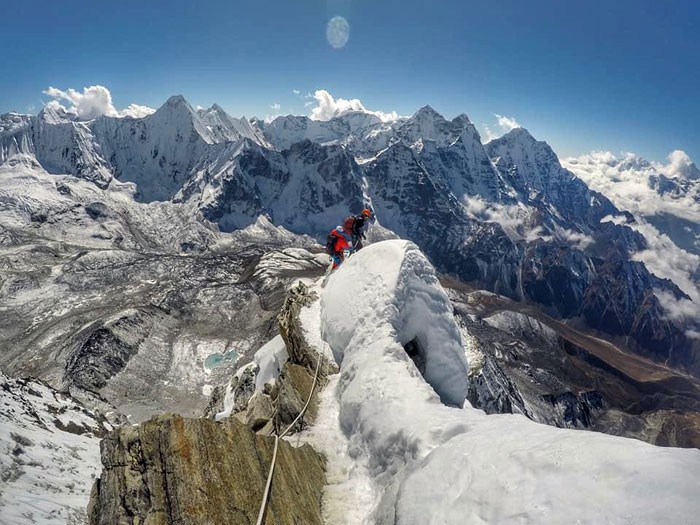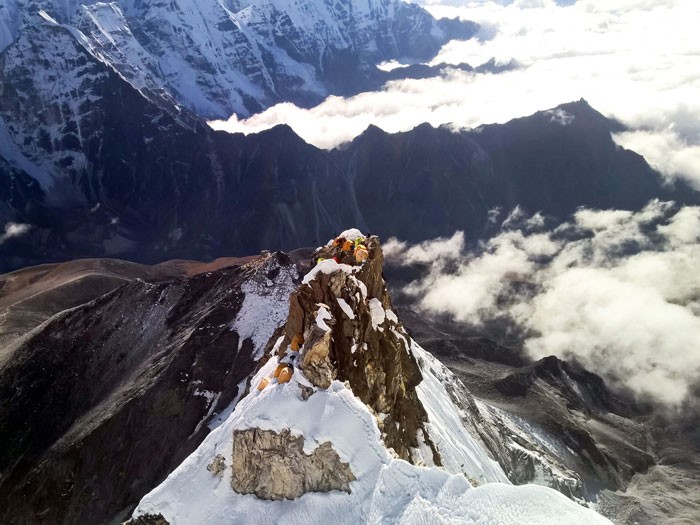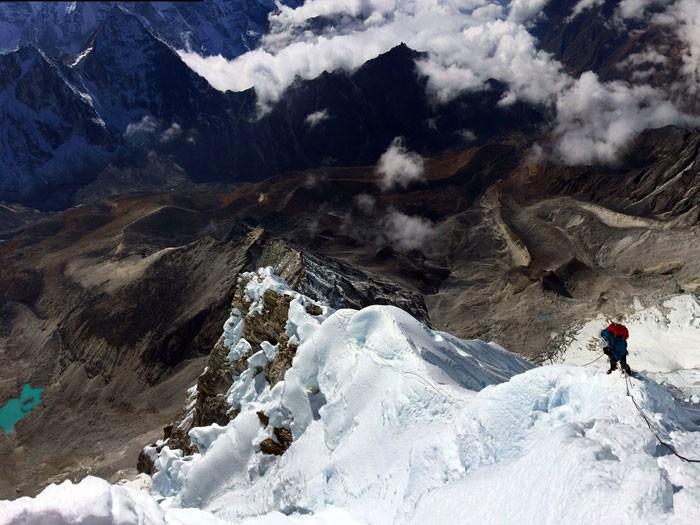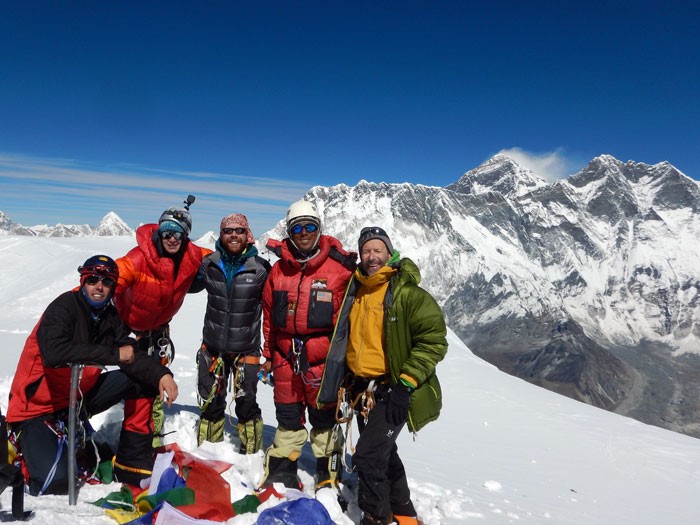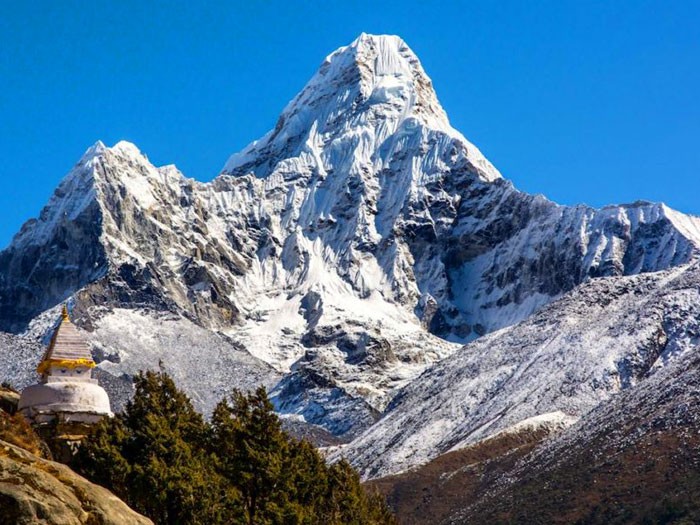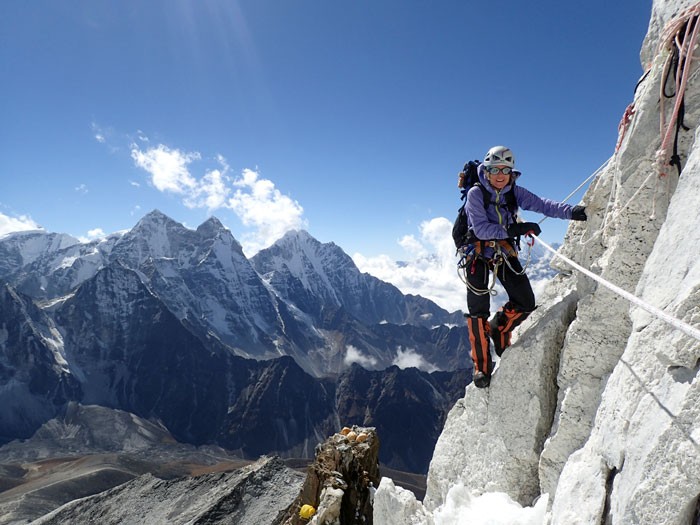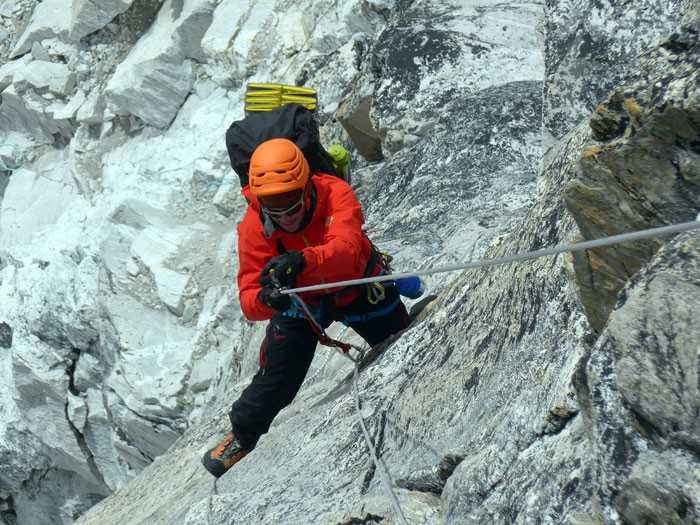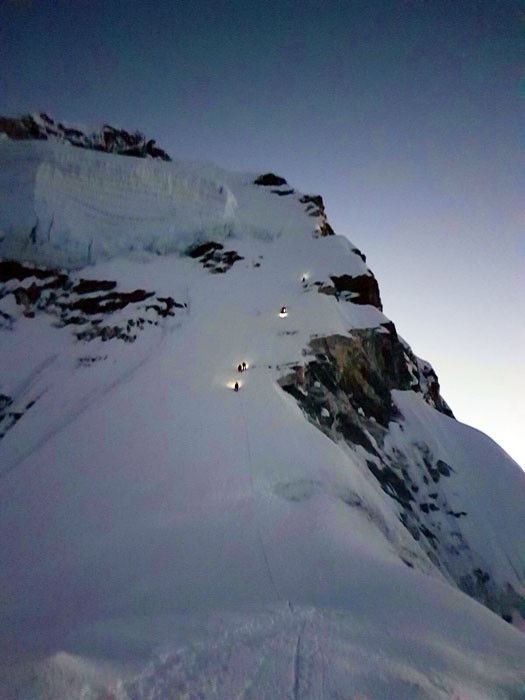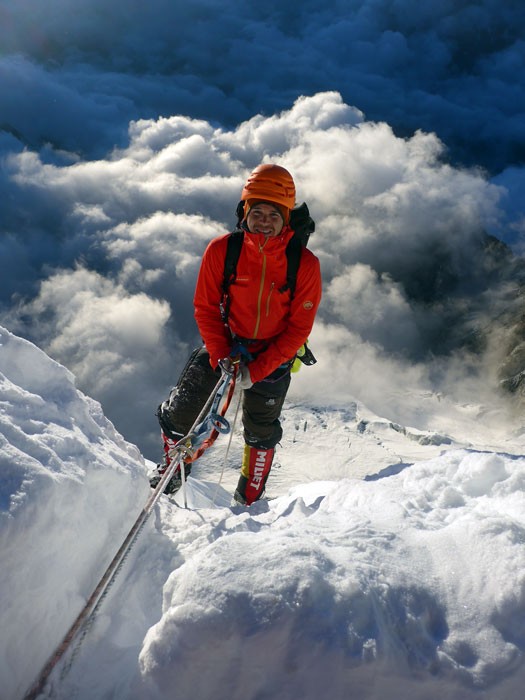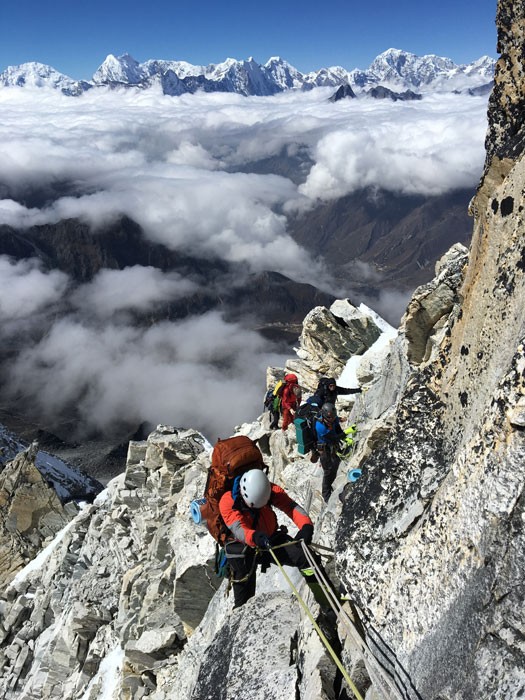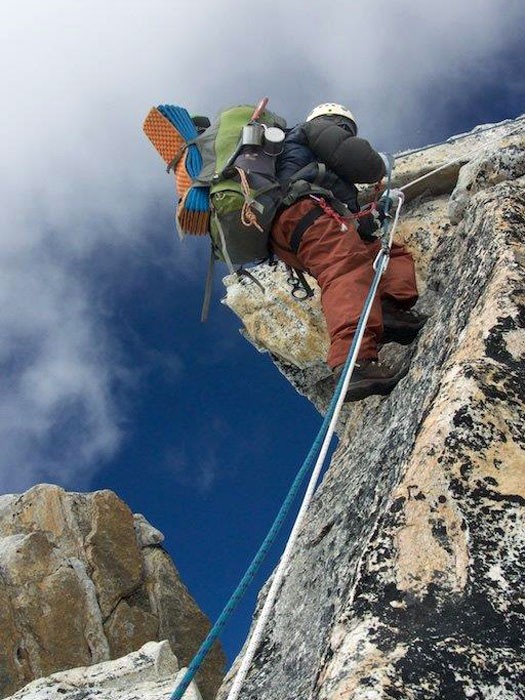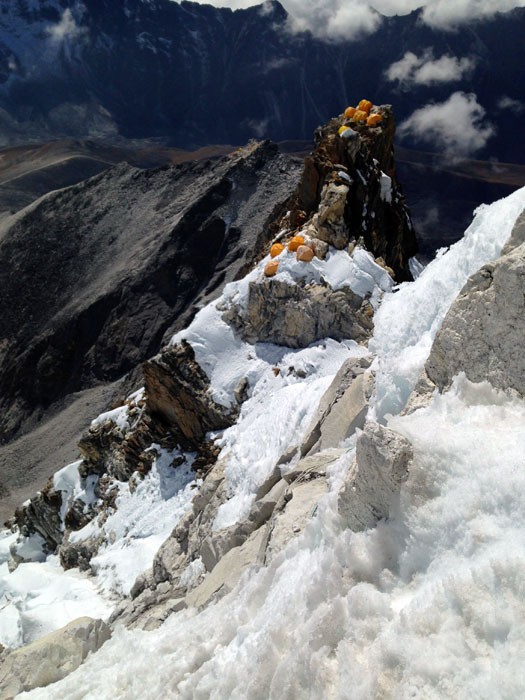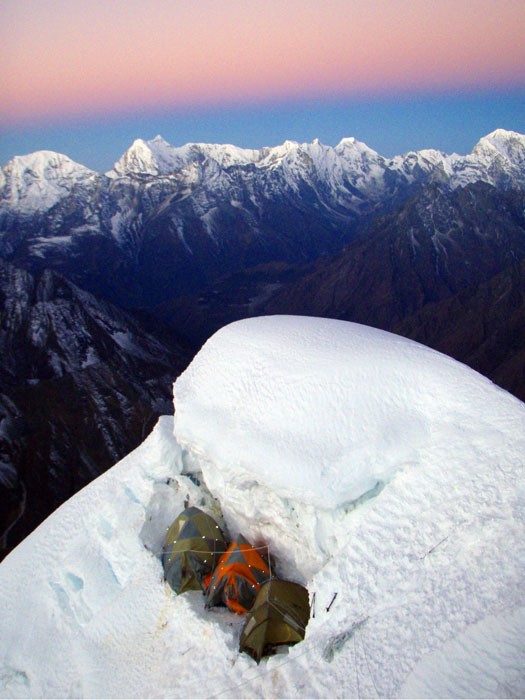Ama Dablam - Nepal
Mount Ama Dablam - (6,812 metres / 22,349 feet, located in Nepal, just 12 miles / 20 kilometres from Everest, is perhaps the most visually striking mountain in the world. The Ama Dablam expedition offers members the opportunity to ascend moderately technical, but very climbable snow, ice, and rock surrounded by stunning Himalayan views)
Easy, fun solid rock & mixed climbing, Safe fixed ropes the expedition is Perfect for beginner, novice and expert climbers. The upper camps on Ama Dablam are world-renowned for their exposure. The Mountain offers coveted expedition for novices and expert climbers alike
Video by Felix
Quick Facts
- Located just 7 miles / 12 km from Everest, with stunning views from the summit.
- Good granite scrambling. Only one pitch is 12 m / 40 ft of UIAA French 4, British Severe, USA 5.6, Aus 14.
- We review skills, train for rock and ice climbing & conduct fixed rope training on cliffs around basecamp.
- Average team size is 6. During 9 prior climbs we were successful in putting 45 members and 30 Sherpas on the summit.
- Short walk to grassy base camp at 4,500 m / 14,500 ft on snow-free paths through Khumbu valley. Green terraced villages, rushing rivers, lush forests, stay in `teahouses', camp beneath towering peaks.Full Service Expedition: British, American, or European leader, Sherpas, hotels, internal flights, yaks, porters, ropes, tasty meals on trek, in basecamp & high camp, group climbing equipment, individual tents, radios, international calls, news updates.
Itinerary
The proposed itinerary allows enough time for proper acclimatization, rest days, and several returns to base camp, where the kitchen and base camp staff can look after all of your needs, and quell your appetite. The weather at this time of year is normally quite good and stable. However, we all know the global weather is changing, and in case of storms, you will note the proposed itinerary includes extra days as well. In previous expeditions, half of those who reached the summit needed every single "extra" day.
Weather - At low elevation, the temperatures can vary from 27°c to -7°c ( 80°f to 20°f). At higher elevations, the temperature can vary from 16°c to -23°c (60°f to -10°f). The wind is the most chilling factor, and can be quite variable, with everything from a flat calm, to hurricane force on the summit. There may be deep snow, heavy rains, mosquitoes in wet areas, blowing dust, burning heat, bright sunshine.
Arriving in Kathmandu - The trip begins in the ancient and colorful city of Kathmandu. You stay in a comfortable, simple, clean hotel, and sample some of the tasty Nepalese, Tibetan and Western-Style cuisine. During your free days in Kathmandu, you shall finalize arrangements, including your group visa, and take some time out for trinket hunting, with potential visits to explore the 17th century splendors of the Monkey Temple, the Durbar Square and old Kings Palace, as well as the ancient city of Patan.
Trekking to Basecamp - For our full-service members, the cost of this expedition includes one of the most beautiful treks in the world. On leaving Kathmandu, we fly to Lukla at 2860 metres/9400 feet, where we meet our yak drivers, and porters. From Lukla we will trek to Phakding (2550 metres/8400 feet) and sleep in a tea house or camp.
We will continue our trek up to Namche Bazaar (3446 metres/11,350 feet), the capital of the Sherpa Kingdom. Here we rest for a day to acclimate, then proceed up to Pangboche (3860 metres/12,700 feet) for a night. The next day we will make the last leg of the trek to basecamp at 4650 metres/15,300 feet. After resting, organizing, and training in basecamp for a day, we will begin our climb.
Moving to Advanced Basecamp - Base Camp (4650 metres/15,300 feet) to Advanced Basecamp (5500 metres/18,150 feet). Ama Dablam is one of the few Himalayan peaks that can be reached without crossing a glacier. We climb a long gravel ridge-slope, and cross a boulder field on the SW ridge where we will place advanced basecamp. There is water here in early October. We have located one of our skillful cooks here in recent years
High Camps - Advanced Basecamp to Camp 1 (5700 metres/18,800 feet). We scramble over large boulders and climb an easy fourth class slab, where we fix a "hand-line". In 2007, we established two kitchens, complete with Nepalese cooks, in both ABC and Camp 1.
Camp 1 to Camp 2 (6000 metres/19,800 feet). We scramble-climb along an easy fourth class horizontal rock ridge and around several pinnacles, gaining only 300 metres/1000 feet, vertical. The exposure is huge, with massive drop-offs on both sides of the ridge. The climbing is very enjoyable with good quality granite. At the end of the horizontal ridge we climb the Yellow Tower with 6 metres, 20 feet of French 4th class, British Severe, North American 5.5. Above the Yellow Tower we place Camp 2 on ledges and a flat-topped rock pinnacle. Camp 2 is probably the most "airy" site you will ever pitch a tent on. Please be very careful when you go to the toilet.
Summit Day - Camp 2 to the Summit (6812 metres/22,349 feet). From camp 2, a steep snow ridge is climbed through the Grey Tower, with one move of French Class 4, British Severe, or 5.5, then multiple fourth class-scrambling pitches in snow, rock and ice. A snow-rock-ice chute is climbed to gain the ridge traverse, named the "mushroom-ridge", which is a very bizarre but fairly stable formation. This is followed to the right side of the base of the Dablam, where camp 3 is made on a broad flat snowfield. In recent years, due to risk of avalanche, we have only used camp 3 as a stop to make hot drinks and rewarm our feet and we have not slept overnight there.
Two easy pitches of dramatic but very solid 40+ degree snow-ice are climbed to the side of the Dablam to reach the fluted, but very easy and solid, 30-48 degree snowfields that lead to one of the worlds finest summits, where you will be treated to incredibly stunning views of the south Face of Lhotse, Nuptse, Mount Everest, Cho Oyu, Pumori, Shishapangma, Makalu, and the Khumbu Himal.
Going Home - After packing up all of your equipment, supplies, and rubbish, you will make a short return trek the way we came to Lukla to catch our flight back to Kathmandu. Back in Kathmandu, you can enjoy a hot shower and a grand Nepalese western-style feast. You can have a day to relax, celebrate, tour the valley, write postcards, and do a bit more shopping, before heading home. We hope you had a safe, enjoyable, and successful adventure. Please Click here for more details
Another special feature, Ama Dablam has no glacier at it’s base instead, Ama Dablam’s basecamp is on grass which is quite low as well, being situated at just 4500 metres / 14,750 feet. Another outstanding feature is Ama Dablam’s relative ease of access. Its only 5 short days of trekking from Lukla to Ama Dablam basecamp. This includes 1 rest day in Namche as well.
In the past, October Post-Monsoon was a favorable period given its warm temperatures and reinvigoration of the snow slopes due to the monsoon. However, this month has become less popular for two reasons:
- Nowadays the monsoon often persists until around the 10th or 15th of October, at which point powerful storms may disrupt or delay climbing season.
- Additionally, it is now busier in October and climbers could face lines to summit Yellow Tower and shortages of tent sites in Camp 2.
Wind and snow googles are important, as are clear lenses for high winds at night to prevent snow/wind blindness.
Climbing gloves are necessary to have. Gore-Tex windshell layers of trousers and jackets are brilliant to have as are expedition weight thermal shirt and long underwear leggings. Be sure to bring a warm sleeping bag. A good quality 60 liter back pack seems to be the perfect size. We purchase our mattresses in Lukla where they have a nice selection of thick foam matts for basecamp and folding closed cell foam (karri) matts for the high mountain.
All group gear like ropes, rock and ice protection, tents, stoves, fuel, food, walkie talkies, is included
Our leaders and staff will come to your hotel to look at the clothing, shoes, and equipment you have brought, and then they will take you shopping in equipment shops to purchase and rent/hire everything you might need.
- Small personal first-aid kit. (Simple and Light) Aspirin, first-aid tape, plasters (band-aids), personal medications, etc.
- Blister repair kit
- 10 anti-diarrhea pills
- 20 anti-headache pills
- 10 cough and/or cold medicine
- Anti-altitude sickness pills: Diamox, Acetylzolamide
- 10 Stomach antibiotics: Ciprofloxacin, etc.
- 5 Azithromycin tables
- Steri pen or bottle of water purification tablets
- Cough sweets/lozenges (Halls/Stepils)
- Earplugs
- Extra prescription glasses/contact lenses and supplies
To participate in this expedition you must be a very fit and active winter-walker-climber in good health. Prior to joining our group, please see your doctor and obtain the necessary permission and advice, as well as medications for travel in extremes of altitude, and also for exotic locales.
Ama Dablam Expedition Cost
Ama Dablam : Our full-service expedition includes:
- British, European, and American leader
- Expert climbing Sherpas for the group (personal Sherpas available upon request)
- Full service trek to base camp with all teahouses and all meals
- Round trip return transport and flights for you and your gear from KTM-Lukla and Lukla to KTM
- Personal equipment check in KTM and guided shopping trips for renting/hiring and purchasing
- Meeting you at the airport and airport transfer to the hotel
- Yak, donkey and porter transport of all equipment to and from basecamp
- Skillful base camp cooks
- Three meals each day, on trek, in basecamp, and at high altitude above basecamp
- Group emergency equipment, medical equipment and satellite phone
- Comfortable base camp with dining mess tent, tables and chairs, showers, bathroom, and solar charger
- Guided training on cliffs and glaciers around basecamp
- All ropes, tents and high altitude climbing equipment.
- Full high altitude service to the summit and back
- All permit fees and liaison officers
- Two nights stay in a clean comfortable conveniently located Kathmandu hotel on arrival and two nights prior to departure in a double room. Private rooms are available for a small additional fee.
What is not included?
- International flights to/from Kathmandu
- Mountain climbing rescue and travel insurance
- Personal climbing equipment and clothing
- Gratuities for staff
- Nepalese visa
Add on High Attitude Support : Click here for prices
- Private Sherpa (personal guide/porter) – Carries up to 10 kg (22bs) of your personal equipment, climbs with you, helps with clipping and unclipping from the fixed lines at each anchor, and will be with you every step of the way.
- Personal equipment carriage service – Sherpa carry up to 10kg (22lbs) of personal equipment up and down the mountain between camps
Ama Dablam : Our Basic Climb Includes :
- All climbing permit fees and shared expedition liaison officer
- Access to team fixed ropes
- Airport transfers
- Two nights stay in our clean comfortable Kathmandu hotel on arrival and two nights prior to departure in a double room. Private rooms are available for a small additional fee
- Other services and may be purchased and hired at minimal expense
Ama Dablam : Our Basecamp option is for groups of two who want to join the team in basecamp and includes:
- All climbing permit fees and shared expedition liaison officer
- Access to team fixed ropes
- Tents/accomodation in basecamp
- 3 meals per day in basecamp (maximum 12 days in bc)
- Airport transfers between Kathmandu airport and KTM hotel
- Two nights stay in a clean comfortable Kathmandu hotel on arrival and two nights prior to departure in a shared double room. Private rooms are available for a small additional fee.
- You may choose to hire other services from our logistics team as needed.
Another special feature, Ama Dablam has no glacier at it’s base instead, Ama Dablam’s basecamp is on grass which is quite low as well, being situated at just 4500 metres / 14,750 feet. Another outstanding feature is Ama Dablam’s relative ease of access. Its only 5 short days of trekking from Lukla to Ama Dablam basecamp. This includes 1 rest day in Namche as well.
In the past, October Post-Monsoon was a favorable period given its warm temperatures and reinvigoration of the snow slopes due to the monsoon. However, this month has become less popular for two reasons:
- Nowadays the monsoon often persists until around the 10th or 15th of October, at which point powerful storms may disrupt or delay climbing season.
- Additionally, it is now busier in October and climbers could face lines to summit Yellow Tower and shortages of tent sites in Camp 2.
Wind and snow googles are important, as are clear lenses for high winds at night to prevent snow/wind blindness.
Climbing gloves are necessary to have. Gore-Tex windshell layers of trousers and jackets are brilliant to have as are expedition weight thermal shirt and long underwear leggings. Be sure to bring a warm sleeping bag. A good quality 60 liter back pack seems to be the perfect size. We purchase our mattresses in Lukla where they have a nice selection of thick foam matts for basecamp and folding closed cell foam (karri) matts for the high mountain.
All group gear like ropes, rock and ice protection, tents, stoves, fuel, food, walkie talkies, is included
Our leaders and staff will come to your hotel to look at the clothing, shoes, and equipment you have brought, and then they will take you shopping in equipment shops to purchase and rent/hire everything you might need.
- Small personal first-aid kit. (Simple and Light) Aspirin, first-aid tape, plasters (band-aids), personal medications, etc.
- Blister repair kit
- 10 anti-diarrhea pills
- 20 anti-headache pills
- 10 cough and/or cold medicine
- Anti-altitude sickness pills: Diamox, Acetylzolamide
- 10 Stomach antibiotics: Ciprofloxacin, etc.
- 5 Azithromycin tables
- Steri pen or bottle of water purification tablets
- Cough sweets/lozenges (Halls/Stepils)
- Earplugs
- Extra prescription glasses/contact lenses and supplies
To participate in this expedition you must be a very fit and active winter-walker-climber in good health. Prior to joining our group, please see your doctor and obtain the necessary permission and advice, as well as medications for travel in extremes of altitude, and also for exotic locales.
Ama Dablam Expedition Itinerary
- 1) Arrive Kathmandu, Nepal, 1,300 metres (4,265 feet). Stay at hotel. equipment checking, gear shopping in Kathmandu. Drive to Ramechap after lunch. Stay at hotel.
- 2) Orientation day,
- 3) Fly to Lukla, 2,900 metres (9,514 feet). Easy short walk to Phakding, 2,550 metres (8,366 feet). Beautiful day of light trekking. Sleep in teahouse.
- 4) Walk to Namche Bazaar, 3,440 metres (11,286 feet). Lovely forest trek over suspension bridges. This big village is the capital of the Sherpa people. Sleep in teahouse.
- 5) Rest & Acclimatization in Namche. Teahouse.
- 6) Walk to Pangboche 3,860 metres (12,644 feet). Famous Everest base camp trekking route with many lodges and restaurants and beautiful scenery of Mt. Ama Dablam. Teahouse.
- 7) Walk to Base Camp 4,570 metres (14,989 feet). Beautiful Ama Dablam basecamp is on grassy meadows. Camp.
- 8) Rest & Acclimatization, Sherpa prayer ceremony (puja).
- 9) Equipment check and fixed rope training day on small cliffs near base camp.
- 10) Walk to advanced basecamp, 5,350 metres (17,552 feet). Easy walking on paths. Sleep there.
- 11) Hike to camp 1, 5,700 metres (18,701 feet). A bit of rockhopping in a boulder field, followed by short easy low angle scramble to C1. Return to basecamp.
- 12) Rest and acclimatization in basecamp.
- 13) Walk to Camp 1. Sleep there.
- 14) Rest in Camp 1.
- 15) Climb to camp 2, 5,900 metres (19,357 feet). Easy climbing to C2 is on good solid granite, using fixed ropes. Return to basecamp.
- 16) Rest in basecamp.
- 17) Rest in basecamp.
- 18) Walk to Camp 1.
- 19) Climb to Camp 2.
- 20) Wake up in the night, eat "breakfast" and attempt the summit: 6,812 metres (22,349 feet). Summit attempt involves easy snow climbing with a bit of simple mixed rock just above C2. Return and sleep in C2.
- 21) Extra day for summit attempt.
- 22) Downclimb and walk down to basecamp.
- 23) Pack up and descend to Pangboche village. Sleep in teahouse.
- 24) Walk down to Namche Bazaar. Teahouse.
- 25) Walk down from Namche to Lukla. Teahouse.
- 26) Fly from Lukla to Kathmandu.
- 27) Extra day in Kathmandu, in case of delay, and for sightseeing, gift shopping, celebration, saying goodbye to new friends. Stay in hotel.
- 28) Fly home.
Lobuche Peak and Ama Dablam Expedition Itinerary
- 26 Oct - Arrive in Nepal
- 27 Oct - Orientation day, equipment checking, gear shopping in Kathmandu. Drive to Ramechap after lunch. Stay at hotel.
- 28 Oct - Fly to Lukla, 2,900 metres (9,514 feet). Easy short walk to Phakding, 2,550 metres (8,366 feet). Beautiful day of light trekking. Sleep in teahouse.
- 29 Oct - Walk to Namche Bazaar, 3,440 metres (11,286 feet). Lovely forest trek over suspension bridges. This big village is the capital of the Sherpa people. Sleep in teahouse.
- 30 Oct - Rest & Acclimatization in Namche. Teahouse.
- 31 Oct - Walk to Pangboche 3,860 metres (12,644 feet). Famous Everest base camp trekking route with many lodges and restaurants and beautiful scenery of Mt. Ama Dablam. Teahouse.
- 1 Nov - Trek to Dingboche
- 2 Nov - Rest in Dingboche.
- 3 Nov - Trek to Dzongla.
- 4 Nov - Walk to Lobuche high camp.
- 5 Nov - Climb Lobuche Peak, return to camp
- 6 Nov - Walk to Pangboche
- 7 Nov - Walk to Ama Dablam Base Camp 4,570 metres (14,989 feet). Beautiful Ama Dablam basecamp is on grassy meadows. Camp.
- 8 Nov – Sherpa Prayer Ceremony (Puja) in Base Camp. Rest & Acclimatization,
- 9 Nov - Equipment check and fixed rope training day on small cliffs near base camp.
- 10 Nov - Walk to advanced basecamp, 5,350 metres (17,552 feet). Easy walking on paths. Sleep there.
- 11 Nov - Hike to camp 1, 5,700 metres (18,701 feet). A bit of rockhopping in a boulder field, followed by short easy low angle scramble to C1
- 12 Nov - Rest in Camp 1.
- 13 Nov - Climb to camp 2, 5,900 metres (19,357 feet). Easy climbing to C2 is on good solid granite, using fixed ropes.
- 14 Nov - Wake up in the night, eat "breakfast" and attempt the summit: 6,812 metres (22,349 feet). Summit attempt involves easy snow climbing with a bit of simple mixed rock just above C2. Return and sleep in C2.
- 15 Nov - Extra day for summit attempt.
- 16 Nov - Downclimb and walk down to basecamp.
- 17 Nov - Pack up and descend to Pangboche village. Sleep in teahouse.
- 18 Nov - Walk down to Namche Bazaar. Teahouse.
- 19 Nov - Walk down from Namche to Lukla. Teahouse.
- 20 Nov - Fly from Lukla to Kathmandu.
- 21 Nov - Extra day in Kathmandu, in case of delay, and for sightseeing, gift shopping, celebration, saying goodbye to new friends. Stay in hotel.
- 22 Nov - Fly back to home country.
Another special feature, Ama Dablam has no glacier at it’s base instead, Ama Dablam’s basecamp is on grass which is quite low as well, being situated at just 4500 metres / 14,750 feet. Another outstanding feature is Ama Dablam’s relative ease of access. Its only 5 short days of trekking from Lukla to Ama Dablam basecamp. This includes 1 rest day in Namche as well.
In the past, October Post-Monsoon was a favorable period given its warm temperatures and reinvigoration of the snow slopes due to the monsoon. However, this month has become less popular for two reasons:
- Nowadays the monsoon often persists until around the 10th or 15th of October, at which point powerful storms may disrupt or delay climbing season.
- Additionally, it is now busier in October and climbers could face lines to summit Yellow Tower and shortages of tent sites in Camp 2.
Wind and snow googles are important, as are clear lenses for high winds at night to prevent snow/wind blindness.
Climbing gloves are necessary to have. Gore-Tex windshell layers of trousers and jackets are brilliant to have as are expedition weight thermal shirt and long underwear leggings. Be sure to bring a warm sleeping bag. A good quality 60 liter back pack seems to be the perfect size. We purchase our mattresses in Lukla where they have a nice selection of thick foam matts for basecamp and folding closed cell foam (karri) matts for the high mountain.
All group gear like ropes, rock and ice protection, tents, stoves, fuel, food, walkie talkies, is included
Our leaders and staff will come to your hotel to look at the clothing, shoes, and equipment you have brought, and then they will take you shopping in equipment shops to purchase and rent/hire everything you might need.
- Small personal first-aid kit. (Simple and Light) Aspirin, first-aid tape, plasters (band-aids), personal medications, etc.
- Blister repair kit
- 10 anti-diarrhea pills
- 20 anti-headache pills
- 10 cough and/or cold medicine
- Anti-altitude sickness pills: Diamox, Acetylzolamide
- 10 Stomach antibiotics: Ciprofloxacin, etc.
- 5 Azithromycin tables
- Steri pen or bottle of water purification tablets
- Cough sweets/lozenges (Halls/Stepils)
- Earplugs
- Extra prescription glasses/contact lenses and supplies
To participate in this expedition you must be a very fit and active winter-walker-climber in good health. Prior to joining our group, please see your doctor and obtain the necessary permission and advice, as well as medications for travel in extremes of altitude, and also for exotic locales.
Ama Dablam climbing expedition leadership and staff
Leadership: Dan Mazur is a relaxed, friendly, well organized, and highly skilled professional with over 20 years of experience leading people to the summits of Everest, K2, Broad Peak, Gasherbrum, Cho Oyu, Lhotse, Manaslu, Shishapangma and Baruntse.
Sherpas: We employ some of Nepal, Tibet, and the Karakorum’s best local mountaineers and Sherpas to assist team members in realizing their summit goals. Our friendly and loyal high altitude climbing staff has supported teams to the summits of more than ten of the highest peaks in the Himalaya.
Another special feature, Ama Dablam has no glacier at it’s base instead, Ama Dablam’s basecamp is on grass which is quite low as well, being situated at just 4500 metres / 14,750 feet. Another outstanding feature is Ama Dablam’s relative ease of access. Its only 5 short days of trekking from Lukla to Ama Dablam basecamp. This includes 1 rest day in Namche as well.
In the past, October Post-Monsoon was a favorable period given its warm temperatures and reinvigoration of the snow slopes due to the monsoon. However, this month has become less popular for two reasons:
- Nowadays the monsoon often persists until around the 10th or 15th of October, at which point powerful storms may disrupt or delay climbing season.
- Additionally, it is now busier in October and climbers could face lines to summit Yellow Tower and shortages of tent sites in Camp 2.
Wind and snow googles are important, as are clear lenses for high winds at night to prevent snow/wind blindness.
Climbing gloves are necessary to have. Gore-Tex windshell layers of trousers and jackets are brilliant to have as are expedition weight thermal shirt and long underwear leggings. Be sure to bring a warm sleeping bag. A good quality 60 liter back pack seems to be the perfect size. We purchase our mattresses in Lukla where they have a nice selection of thick foam matts for basecamp and folding closed cell foam (karri) matts for the high mountain.
All group gear like ropes, rock and ice protection, tents, stoves, fuel, food, walkie talkies, is included
Our leaders and staff will come to your hotel to look at the clothing, shoes, and equipment you have brought, and then they will take you shopping in equipment shops to purchase and rent/hire everything you might need.
- Small personal first-aid kit. (Simple and Light) Aspirin, first-aid tape, plasters (band-aids), personal medications, etc.
- Blister repair kit
- 10 anti-diarrhea pills
- 20 anti-headache pills
- 10 cough and/or cold medicine
- Anti-altitude sickness pills: Diamox, Acetylzolamide
- 10 Stomach antibiotics: Ciprofloxacin, etc.
- 5 Azithromycin tables
- Steri pen or bottle of water purification tablets
- Cough sweets/lozenges (Halls/Stepils)
- Earplugs
- Extra prescription glasses/contact lenses and supplies
To participate in this expedition you must be a very fit and active winter-walker-climber in good health. Prior to joining our group, please see your doctor and obtain the necessary permission and advice, as well as medications for travel in extremes of altitude, and also for exotic locales.
Ama Dablam climb personal and team equipment
Climbing:
- Climbing harness
- 5 meters (16 ft.) of 6mm accessory cord
- Figure 8 abseil/belay device (tube style devices, i.e. ATC will not work on fixed lines)
- Full size ascender (i.e. PetzlAscention)
- 2 locking carabiners, 1 large and 1 small
- 4 non-locking carabiners
- Ice axe with leash
- Steel crampons with anti-balling plates
- Trekking poles
- Abseiling/Rappelling Gloves
Upper Body:
- 2 cotton t-shirts
- 2 synthetic t-shirts
- 2 long sleeve synthetic shirts
- Light-weight soft shell jacket
- Medium weight insulatingjacket (fleece, down, or synthetic)
- Hard shell jacket with hood, waterproof and breathable (Gore-Tex or similar)
- Heavy down coat
- For 6,000m peaks a very warm down coat with hood or an 8,000m coat with hood
- For 7,000m peaks an 8,000m coat with hood
- For 8,000m peaks an 8,000m down coat with hood or an 8,000m suit can be used instead
Hands:
- Lightweight poly-liner gloves
- Mid-weight soft shell gloves – water/wind resistant
- Heavy- weight waterproof gloves – Gore-tex shell with removable liner
- Expedition weight mittens -Gore-tex over mitt matched polar fleece mitt liner
Head:
- Helmet
- Warm hat that covers your ears
- Balaclava
- Face mask
- Baseball hat or brimmed sun hat
- Glacier sunglasses with side shields
- Ski goggles with light and dark lenses
- Glasses with clear lenses to protect your eyes while climbing to the summit on windy nights. (cost less than 10 dollars in Kathmandu)
- Headlamp with extra batteries and bulbs
- Buff/neck gaiter
- Bandana or head scarf (optional)
Lower Body:
- Synthetic underwear
- Hiking shorts
- Hiking pants
- 2 pair lightweight thermal bottoms
- Medium or expedition weight thermal bottoms
- Polar fleece or soft shell pants
- Waterproof/breathable pants with full side zips (Gore-Tex or similar)
- Heavy insulating pants
- For 6,000m peaks: Down or synthetic pants will full zips
- For 7,000m peaks: 8,000m down pants
- For 8,000m peaks: 8,000m down pants or a 8,000m suit can be used instead
Feet:
- Boots
- For 6,000m peaks: Plastic or composite double boots (Koflach, La SportivaSpantik, etc) Modern waterproof, single boots designed for 4-5,000m peaks may be suitable if they can be worn with 2 pairs of socks and vapor barrier lines and/or they are equipped with overboots
- For 7,000m: Plastic or composite double boots (Koflach, La SportivaSpantik, etc)
- For 8,000m peaks: 8,000m boots - One-Sport Millet Everest boots or equivalent
- Sturdy leather walking boots
- Trainers, running shoes and/or sandals
- Down booties (optional)
- 3 pair med-heavy poly or wool socks
- 2 pair poly or wool liner socks (optional)
- Vapor barrier liner socks (optional)
- 2 pair lightweight trekking socks
- Cotton socks for in town
Sleeping:
- Down sleeping bag
- For 6,000m peaks: -18C or 0F
- For 7,000m peaks:-23C or -10F (If you sleep cold consider -29C or -20F)
- For 8,000m peaks: -29C or -20F (If you sleep cold consider -40C or -40F)
- An additional down sleeping bag for basecamp for the following climbs: Everest, Lhotse, AmaDablam, Manaslu, Cho Oyu, Shishapangma, Broad Peak, K2, Gasherbrum I and II, Spantik, K2/Broad Peak Everest training climb. For Mastagata a second sleeping bag is optional, but highly recommended.
- Down base camp sleeping bag should be rated to -10C or 15F (If you sleep cold consider -18C or 0F)
- Down base camp sleeping bag should be rated to -10C or 15F (If you sleep cold consider -18C or 0F)
- 2 closed cell foam kari-mats (sleeping pads) for use in basecamp and high altitude (these can be purchased inexpensively in Kathmandu)
- High quality inflatable sleeping pad designed for cold weather (Thermarest)
- Patch kit for inflatable pad
Rucksack and Travel Bags:
- Medium rucksack/backpack (50-70 litres / 3000-4500 cubic inches, can be used as carry-on bag)
- Waterproof rucksack cover (optional)
- 2 large (120+ L / 7500+ cubic inch) duffle kit bags for clothing and equipment
- Small luggage locks for duffel kit bags
Personal Hygiene:
- Female or male hygiene supplies
- 2 tubes lip sun cream
- Large tube skin sun cream (min factor 30)
- Anti-mosquito cream
- Toothpaste/brush
- Hand sanitizer gel (small-medium bottle)
- Bar of soap small towel
- Hand wipes
- Face Mask
- Hand sanitiser
- Disposable gloves
- Disinfectant wipes
Medical:
- Small personal first-aid kit. (Simple and Light) Aspirin, first-aid tape, plasters (band-aids), personal medications, etc.
- Blister repair kit
- 10 anti-diarrhea pills
- 20 anti-headache pills
- 10 cough and/or cold medicine
- Anti-altitude sickness pills: Diamox, Acetylzolamide
- 10 Stomach antibiotics: Ciprofloxacin, etc.
- 5 Azithromycin tables
- Steri pen or bottle of water purification tablets
- Cough sweets/lozenges (Halls/Stepils)
- Earplugs
- Extra prescription glasses/contact lenses and supplies
Personal Food:
- Snack food/daily energy food
- Everest training Nepal/Tibet, AmaDablam, Baruntse: 2-4kg (4.5-9lbs)
- Spantik, Cho Oyu, Shishapangma, Mustagata, Manasu: 2-5kg (4.5-11lbs)
- Broad Peak, K2, Gasherbrum I/II, K2/Everest training, Everest, Lhotse: 3-6kg (6.5-13lbs)
- Dehydrated meals (freeze-dried dinners) for summit attempt
- Everest training Nepal/Tibet, AmaDablam: 2 meals
- Spantik, Cho Oyu, Shishapangma, Mustagata, Manasu, Baruntse: 3 meals
- Broad Peak, K2, Gasherbrum I/II, K2/Everest training, Everest, Lhotse: 5 meals
- Small roll of repair tape
- Sewing repair kit
- Cigarette lighter
- Small box matches
- Compass or GPS
- Battery powered alarm clock/watch
- Camera with extra cards and extra batteries
- Nylon stuff sacks for food and gear storage
- 2 water bottles (1 litre) wide-mouth Nalgene
- Pee bottle (1litre or larger)
- Plastic cup and spoon
- Small folding knife
- Binoculars (optional)
- 4 very large, waterproof, heavy duty disposable rubbish sacks size 150-200 litre = 40-50 gallon. These are necessary for packing. thanks
- Passport, 2 extra passport photos, flight ticket, flight itinerary
- Separate photocopies of passport and relevant visa pages, proof of insurance
- Dollars, pounds, or euros cash
- Bank/ATM/Cash and credit cards
- Bathing suit/swim suit (you never know)
- Paperback books, playing cards, ipod/mp3 player, musical instruments, extra batteries, etc.
- Travel clothes for basecamp and in town
- Umbrella (optional)
- Small solar panels for personal electronics (optional)
Group Equipment:
We provide group gear, equipment, and supplies including: rope, ice, rock, and snow anchor protection, tents; stoves, fuel, walkie-talkie radios, bamboo marker wands, etcetera. A personal tent will be provided for each member at base camp. On the upper mountain, team members will share tents. In base camp, a shower, toilet, solar charger, and a dining tent will be provided
You can hire or buy equipment in Kathmandu. Please see the prices here: Equipment for Climbs and Trek: Renting and Purchasing
Another special feature, Ama Dablam has no glacier at it’s base instead, Ama Dablam’s basecamp is on grass which is quite low as well, being situated at just 4500 metres / 14,750 feet. Another outstanding feature is Ama Dablam’s relative ease of access. Its only 5 short days of trekking from Lukla to Ama Dablam basecamp. This includes 1 rest day in Namche as well.
In the past, October Post-Monsoon was a favorable period given its warm temperatures and reinvigoration of the snow slopes due to the monsoon. However, this month has become less popular for two reasons:
- Nowadays the monsoon often persists until around the 10th or 15th of October, at which point powerful storms may disrupt or delay climbing season.
- Additionally, it is now busier in October and climbers could face lines to summit Yellow Tower and shortages of tent sites in Camp 2.
Wind and snow googles are important, as are clear lenses for high winds at night to prevent snow/wind blindness.
Climbing gloves are necessary to have. Gore-Tex windshell layers of trousers and jackets are brilliant to have as are expedition weight thermal shirt and long underwear leggings. Be sure to bring a warm sleeping bag. A good quality 60 liter back pack seems to be the perfect size. We purchase our mattresses in Lukla where they have a nice selection of thick foam matts for basecamp and folding closed cell foam (karri) matts for the high mountain.
All group gear like ropes, rock and ice protection, tents, stoves, fuel, food, walkie talkies, is included
Our leaders and staff will come to your hotel to look at the clothing, shoes, and equipment you have brought, and then they will take you shopping in equipment shops to purchase and rent/hire everything you might need.
- Small personal first-aid kit. (Simple and Light) Aspirin, first-aid tape, plasters (band-aids), personal medications, etc.
- Blister repair kit
- 10 anti-diarrhea pills
- 20 anti-headache pills
- 10 cough and/or cold medicine
- Anti-altitude sickness pills: Diamox, Acetylzolamide
- 10 Stomach antibiotics: Ciprofloxacin, etc.
- 5 Azithromycin tables
- Steri pen or bottle of water purification tablets
- Cough sweets/lozenges (Halls/Stepils)
- Earplugs
- Extra prescription glasses/contact lenses and supplies
To participate in this expedition you must be a very fit and active winter-walker-climber in good health. Prior to joining our group, please see your doctor and obtain the necessary permission and advice, as well as medications for travel in extremes of altitude, and also for exotic locales.
Ama Dablam Expedition Experience and Training
Extensive experience is not required for climbing Ama Dablam. We will conduct extensive climbing training on cliffs near basecamp. Members will be fit and it would be good to have knowledge of roped climbing and descending techniques. It is not necessary for members to know how to lead climb, as our very experienced leaders and Sherpas fix the ropes.
To participate in this expedition you must be a very fit and active winter-walker-climber in good health. Prior to joining our group, please see your doctor and obtain the necessary permission and advice, as well as medications for travel in extremes of altitude, and also for exotic locales.
Another special feature, Ama Dablam has no glacier at it’s base instead, Ama Dablam’s basecamp is on grass which is quite low as well, being situated at just 4500 metres / 14,750 feet. Another outstanding feature is Ama Dablam’s relative ease of access. Its only 5 short days of trekking from Lukla to Ama Dablam basecamp. This includes 1 rest day in Namche as well.
In the past, October Post-Monsoon was a favorable period given its warm temperatures and reinvigoration of the snow slopes due to the monsoon. However, this month has become less popular for two reasons:
- Nowadays the monsoon often persists until around the 10th or 15th of October, at which point powerful storms may disrupt or delay climbing season.
- Additionally, it is now busier in October and climbers could face lines to summit Yellow Tower and shortages of tent sites in Camp 2.
Wind and snow googles are important, as are clear lenses for high winds at night to prevent snow/wind blindness.
Climbing gloves are necessary to have. Gore-Tex windshell layers of trousers and jackets are brilliant to have as are expedition weight thermal shirt and long underwear leggings. Be sure to bring a warm sleeping bag. A good quality 60 liter back pack seems to be the perfect size. We purchase our mattresses in Lukla where they have a nice selection of thick foam matts for basecamp and folding closed cell foam (karri) matts for the high mountain.
All group gear like ropes, rock and ice protection, tents, stoves, fuel, food, walkie talkies, is included
Our leaders and staff will come to your hotel to look at the clothing, shoes, and equipment you have brought, and then they will take you shopping in equipment shops to purchase and rent/hire everything you might need.
- Small personal first-aid kit. (Simple and Light) Aspirin, first-aid tape, plasters (band-aids), personal medications, etc.
- Blister repair kit
- 10 anti-diarrhea pills
- 20 anti-headache pills
- 10 cough and/or cold medicine
- Anti-altitude sickness pills: Diamox, Acetylzolamide
- 10 Stomach antibiotics: Ciprofloxacin, etc.
- 5 Azithromycin tables
- Steri pen or bottle of water purification tablets
- Cough sweets/lozenges (Halls/Stepils)
- Earplugs
- Extra prescription glasses/contact lenses and supplies
To participate in this expedition you must be a very fit and active winter-walker-climber in good health. Prior to joining our group, please see your doctor and obtain the necessary permission and advice, as well as medications for travel in extremes of altitude, and also for exotic locales.
Ama Dablam Application Forms
Please fill out an application and return it to us with your refundable ten-percent deposit to hold your place on the team.
-
Ama Dablam Application for US Team Members : PDF Form or MS Word Doc
-
Ama Dablam Application for all other Team Members : PDF Form or MS Word Doc
In addition to your application, we will need the following at least two months before the Ama Dablam trip begins:
- Completed Payment
- Oxygen order (if any)
- Sherpa order (if any)
- Trip Registration form
- 1 Passport sized photo
- A scan of your passport identification pages
- Complete flight itinerary
- Proof of travel, accident, and repatriation insurance. We strongly recommend Global Rescue, with at least $50,000 worth of helicopter rescue insurance.
- Trip cancellation/interruption insurance is recommended
Please contact us with any questions you may have.
Another special feature, Ama Dablam has no glacier at it’s base instead, Ama Dablam’s basecamp is on grass which is quite low as well, being situated at just 4500 metres / 14,750 feet. Another outstanding feature is Ama Dablam’s relative ease of access. Its only 5 short days of trekking from Lukla to Ama Dablam basecamp. This includes 1 rest day in Namche as well.
In the past, October Post-Monsoon was a favorable period given its warm temperatures and reinvigoration of the snow slopes due to the monsoon. However, this month has become less popular for two reasons:
- Nowadays the monsoon often persists until around the 10th or 15th of October, at which point powerful storms may disrupt or delay climbing season.
- Additionally, it is now busier in October and climbers could face lines to summit Yellow Tower and shortages of tent sites in Camp 2.
Wind and snow googles are important, as are clear lenses for high winds at night to prevent snow/wind blindness.
Climbing gloves are necessary to have. Gore-Tex windshell layers of trousers and jackets are brilliant to have as are expedition weight thermal shirt and long underwear leggings. Be sure to bring a warm sleeping bag. A good quality 60 liter back pack seems to be the perfect size. We purchase our mattresses in Lukla where they have a nice selection of thick foam matts for basecamp and folding closed cell foam (karri) matts for the high mountain.
All group gear like ropes, rock and ice protection, tents, stoves, fuel, food, walkie talkies, is included
Our leaders and staff will come to your hotel to look at the clothing, shoes, and equipment you have brought, and then they will take you shopping in equipment shops to purchase and rent/hire everything you might need.
- Small personal first-aid kit. (Simple and Light) Aspirin, first-aid tape, plasters (band-aids), personal medications, etc.
- Blister repair kit
- 10 anti-diarrhea pills
- 20 anti-headache pills
- 10 cough and/or cold medicine
- Anti-altitude sickness pills: Diamox, Acetylzolamide
- 10 Stomach antibiotics: Ciprofloxacin, etc.
- 5 Azithromycin tables
- Steri pen or bottle of water purification tablets
- Cough sweets/lozenges (Halls/Stepils)
- Earplugs
- Extra prescription glasses/contact lenses and supplies
To participate in this expedition you must be a very fit and active winter-walker-climber in good health. Prior to joining our group, please see your doctor and obtain the necessary permission and advice, as well as medications for travel in extremes of altitude, and also for exotic locales.




